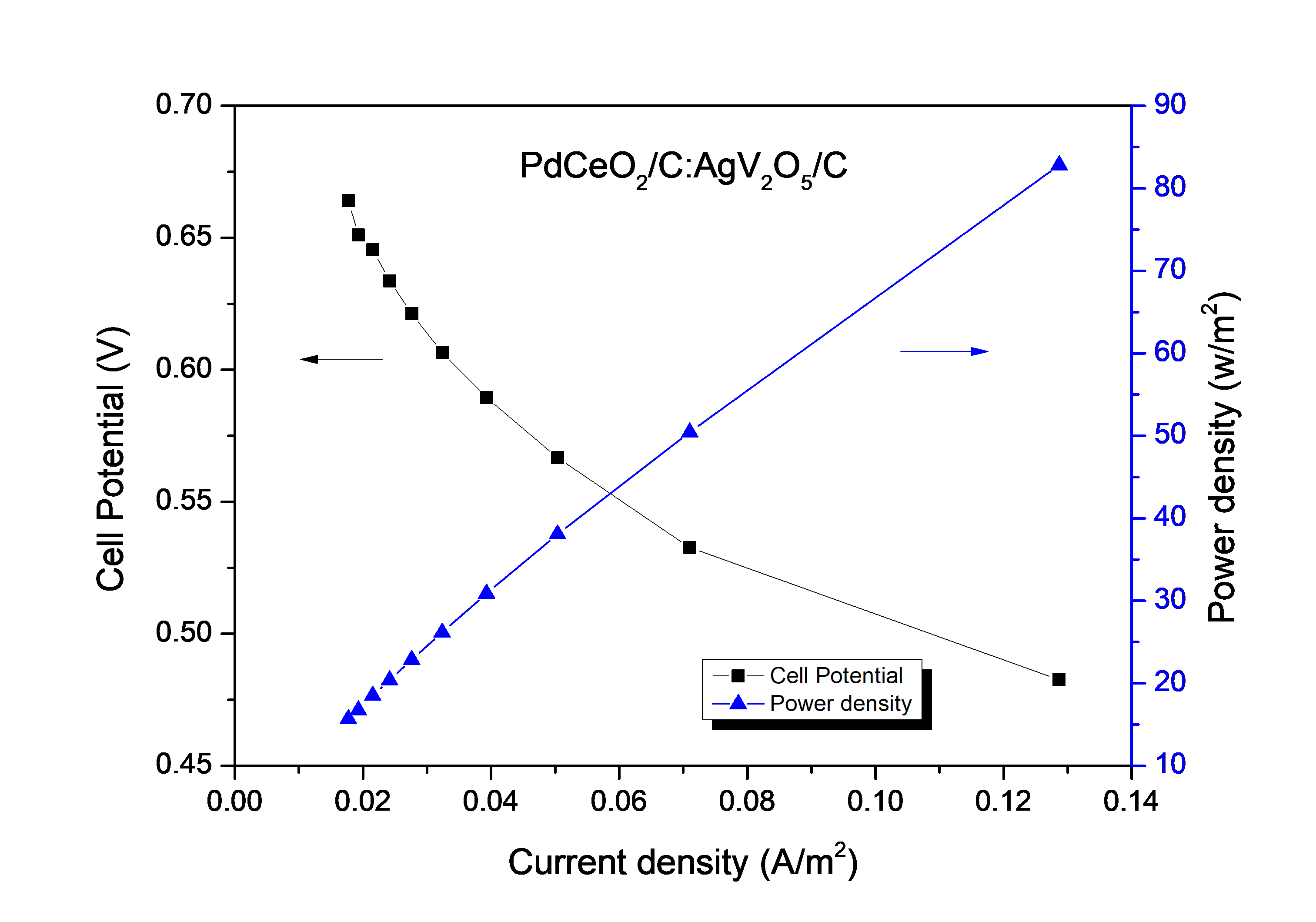Synthesis and Characterization of Sorbitol Membraneless Alkaline Fuel Cell Catalysts for Cathode and Anode, Utilizing AgV2O5/C, AgMnO2/C, and PdCeO2/C Catalysts
DOI:
https://doi.org/10.48048/tis.2024.7311Keywords:
Alkaline fuel cell, Catalyst, Sorbitol, Oxidation reaction, Reduction reaction, Fuel cell, Cathode, AnodeAbstract
This study aimed to develop sorbitol fuel cell catalysts for cathode and anode fuels by synthesizing AgV2O5/C, AgMnO2/C, and PdCeO2/C catalysts. The physical characteristics of the catalysts were analyzed using SEM and EDS. The results showed that the prepared catalysts were small, lumpy, and densely clustered on the carbon surface with small particles. The electrochemical characteristics of the oxidation of alkaline fuels using sorbitol as fuel were investigated by assessing sorbitol concentration ratios of 0.1, 0.2, 0.3, 0.4 and 0.5 per 0.1 M alkaline KOH solution through cyclic voltammetry. The PdCeO2/C catalyst at a concentration of 0.1 M sorbitol solution exhibits the highest potential difference at the potential range of -0.5 to 0.5 V, resulting in a maximum current density of 0.2 mA/cm2. The AgV2O5/C and AgMnO2/C catalysts were tested in the reduction reaction, and the concentration ratios of sorbitol solution per 0.1 M alkaline KOH solution varied from 0.1 to 0.5 M. The results demonstrated a decrease in activity in the catalyst reduction reaction as the sorbitol solution concentration increased, indicating a potential correlation with enhanced oxidation resistance.
HIGHLIGHTS
- In order to achieve the highest efficiency and suitability in an electric cell, it is essential for the AgV2O5/C and AgMnO2/C catalysts to possess excellent resistance to cathode oxidation
- The AgV2O5/C and AgMnO2/C catalysts function as cathode-side catalysts involved in reduction reactions. Consequently, it is imperative for these catalysts to exhibit exceptional resistance to oxidation at the cathode
- At a concentration of 0.1 M KOH solution, the PdCeO2/C catalyst exhibited a maximum oxidation current density of 0.2 mA/cm²
GRAPHICAL ABSTRACT
Downloads
Metrics
References
I Cruz-Reyes, B Trujillo-Navarrete, K García-Tapia, MI Salazar-Gastéluma, F Paraguay-Delgado and RM Félix-Navarro. Pd/MnO2 as a bifunctional electrocatalyst for potential application in alkaline fuel cells. Fuel 2020; 279, 118470.
F Bidault and PH Middleton. 4.07 - Alkaline fuel cells: Theory and application. Compr. Renew. Energ. 2012; 4, 179-201.
K Suwanraksa, P Masjod and C Chaiburi. Bimetallic of Pd-CeOx/C electrocatalyst for electro-oxidation reaction of xylitol fuels in alkaline solutions. KKU Sci. J. 2021; 49, 165-73.
K Suwanraksa, P Masjod and C Chaiburi. Electrochemistry of silver/metal oxide-based catalysts on carbon support for cathode electrode of reducing sugar alkaline fuel cells. Burapha Sci. J. 2022; 27, 1226-37.
I Stosevski, J Krsti, J Miliki, B Sljuki, Z Kcarevic-Popovi, S Mentus and S Miljani. Radiolitically synthesized nano Ag/C catalysts for oxygen reduction and borohydride oxidation reactions in alkaline media, for potential applications in fuel cells. Energy 2016; 101, 79-90.
Q Wu, L Jiang, L Qi, L Yuan, E Wang and G Sun. Electrocatalytic activity and stability of Ag-MnOx/C composites toward oxygen reduction reaction in alkaline solution. Electrochim. Acta 2014; 123, 167-75.
L Feng, J Yang, Y Hu, J Zhu, C Liu and W Xing. Electrocatalytic properties of PdCeOx/C anodic catalyst for formic acid electrooxidation. J. Hydrogen Energ. 2012; 37, 4812-8.
LJ Torres-Pacheco, L Álvarez-Contreras, V Lair, M Cassir, J Ledesma-García, M Guerra-Balcázar and N Arjona. Electrocatalytic evaluation of sorbitol oxidation as a promising fuel in energy conversion using Au/C, Pd/C and Au–Pd/C synthesized through ionic liquids. Fuel 2019; 250, 103-16.
LJ Torres-Pacheco, A Osornio-Villa, NA Garcia-Gomez, A Olivas, R Valdez, M Guerra-Balcazar, L Alvarez-Contreras and N Arjona. Effect of AuM (M: Ag, Pt & Pd) bimetallic nanoparticles on the sorbitol electro-oxidation in alkaline medium. Fuel 2020; 274, 117864.
LJ Torres-Pacheco, AD Leon-Rodriguez, L Alvarez-Contreras, M Guerra-Balcazar and N Arjona. Sorbitol electro-oxidation reaction on sub < 10 nm PtAu bimetallic nanoparticles. Electrochim. Acta 2020; 353, 136593.
C Chaiburi and R Jantong. Investigation of performance of glycerol-tolerant catalysts for cathodes of alkaline glycerol fuel cells. KMUTT Res. Dev. J. 2021; 44, 443-55.
Y Lu, Y Wang and W Chen. Silver nanorods for oxygen reduction: Strong effects of protecting ligand on the electrocatalytic activity. J. Power Sourc. 2011; 196, 3033-8.
MA Kostowskyj, D Kirk and S Thorpe. Ag and Ag–Mn nanowire catalysts for alkaline fuel cells. Int. J. Hydrogen Energ. 2010; 35, 5666-72.
S Ayyaru, S Mahalingam and YH Ahn. A non-noble V2O5 nanorods as an alternative cathode catalyst for microbial fuel cell applications. Int. J. Hydrogen Energ. 2019; 44, 4974-84.
D Basu and S Basu. A study on direct glucose and fructose alkaline fuel cell. Electrochim. Acta 2010; 55, 5775-9.
T Priamushko, R Guillet-Nicolas and F Kleitz. Mesoporous nanocast electrocatalysts for oxygen reduction and oxygen evolution reactions. Inorganics 2019; 7, 98.
P Masjod, K Suwanraksa and C Chaiburi. Development of binary catalysts support for the electro-oxidation reaction enhancement of glycerol alkaline fuel cell. Thaksin Univ. J. 2020; 23, 55-64.

Downloads
Published
How to Cite
Issue
Section
License
Copyright (c) 2023 Walailak University

This work is licensed under a Creative Commons Attribution-NonCommercial-NoDerivatives 4.0 International License.






